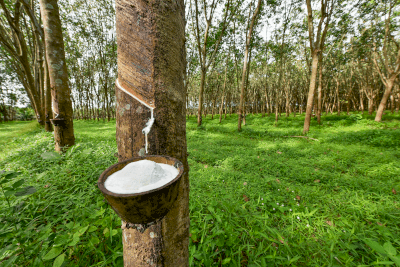What Is Natural Rubber?

Natural rubber is rubber standardized as “cis-1,4-polyisprene obtained from the Pará rubber tree”.
Therefore, the main production areas of natural rubber are the tropical regions of Southeast Asia, Africa, and Central and South America, where Pará rubber tree grows. Production of natural rubber in Southeast Asia consists of about 80% of total production.
Natural rubber has been used industrially since the 1800s. It is traded in three main forms: latex, which is liquid rubber; RSS, which is dried in sheet form; and TSR, which is rubber that has been finely ground and press-molded.
RSS is mechanically stronger than TSR, but is also more expensive.
Uses of Natural Rubber
Approximately 70% of natural rubber is used in tires for aircraft, trucks, buses, and passenger cars. To increase the durability of tires, natural rubber is blended with SBR (styrene butadiene rubber) and BR (butadiene rubber), a type of synthetic rubber, to improve durability.
Due in part to the effects of these blends, natural rubber exhibits extremely high mechanical strength and is therefore often used in large tires. Besides tires, natural rubber is used in a wide range of industrial products such as belts, hoses, and anti-vibration rubber feet, as well as in consumer products such as thread rubber, rubber bands, and footwear such as slippers.
It is also sometimes used as an additive to plastics.
Characteristics of Natural Rubber
Natural rubber has excellent extensibility, resilience, tear strength, compression set, abrasion resistance, flexural crack resistance, and adhesiveness, and is characterized by low internal heating and high fracture strength. Like general synthetic rubbers, it has high water and alcohol resistance, but low oil and acid resistance. It also has low resistance to weathering and ozone.
Since natural rubber is derived from natural materials, it may contain impurities and have more inconsistencies in physical properties than synthetic rubbers.
Structure of Natural Rubber
Natural rubber is made from polyisoprene (a polymer of isoprene: CH2=C(CH3)-CH=CH2), which is obtained by adding acid to the white sap called latex that seeps out when a rubber tree is wounded.
Since the isoprene portion has a cis structure, the molecular chain is irregularly shaped and crystallization rarely occurs.
Other Information on Natural Rubber
1. Vulcanization
Vulcanization is the process of adding sulfur and heating. The double bonds in the molecules that make up natural rubber undergo an oxidation reaction over time, causing the rubber to lose its elasticity over time.
Natural rubber also lacks durability in terms of resistance to heat and cold, making it difficult to use as is. Therefore, natural rubber is treated by adding 5-8% sulfur to natural rubber and heating it to approximately 140°C. This process causes the double bonds to react with the sulfur, bonding the molecules together and increasing the chemical strength, mechanical strength, and elasticity of the rubber. Most of the natural rubber used in daily life is vulcanized rubber.
2. Differences From Synthetic Rubber
In addition to natural rubber, there is synthetic rubber which is produced from petroleum or naphtha. It is difficult to distinguish between natural rubber and synthetic rubber visually, and because they have equal specific gravity, it is difficult to determine visuallywhether natural rubber or synthetic rubber is used.
Natural rubber is superior in mechanical properties, but synthetic rubbers, such as fluorine rubber and silicone rubber, have higher heat resistance, oil resistance, and weather resistance, and synthetic rubbers often exhibit better properties other than mechanical strength.
3. Natural Rubber as a Resource
Compared to synthetic rubber, which is derived from petroleum, natural rubber is a very green material because it is naturally derived. In addition, since the Pará rubber tree synthesizes natural rubber by absorbing carbon dioxide, it is indirectly using carbon dioxide from the earth.
After about 25 years from the planting date, the paragum tree is replanted because the harvest of natural rubber is decreasing rapidly, and the paragum trees cut down at this time are mainly processed into laminated wood.
Laminated wood from the Pará rubber tree is widely used for furniture, flooring, and other applications due to its durability, coloring, and paintability. Natural rubber itself, as well as the Pará rubber tree, which produces natural rubber, is a green material.